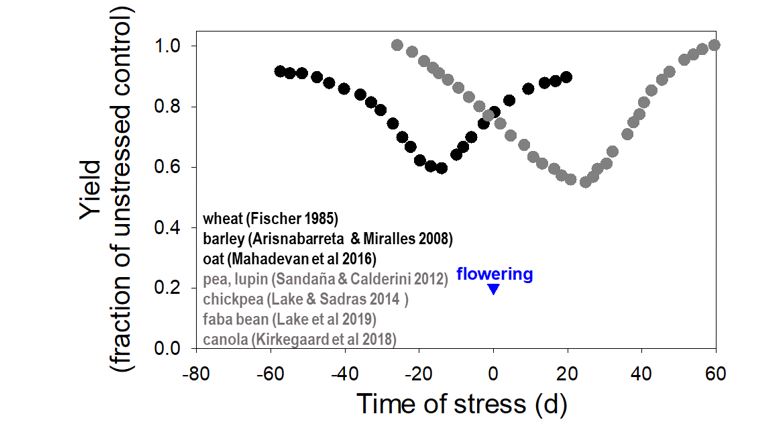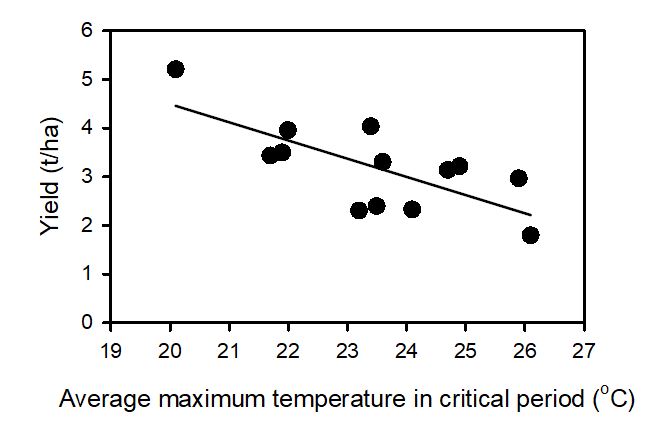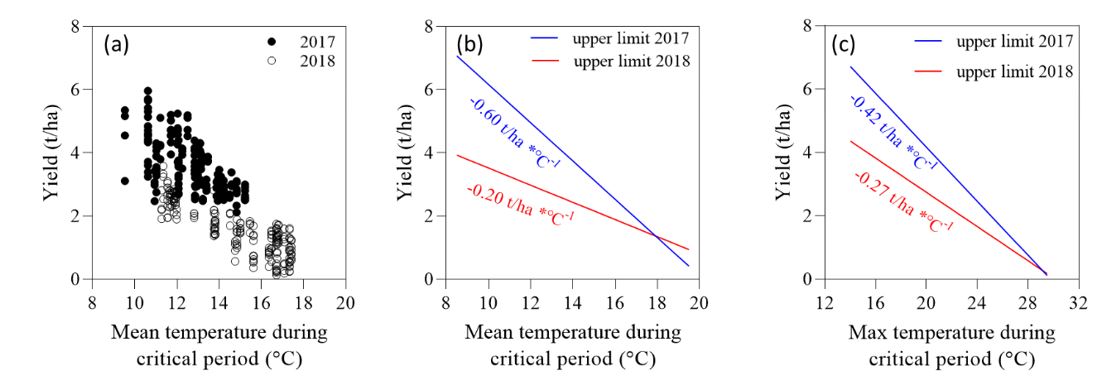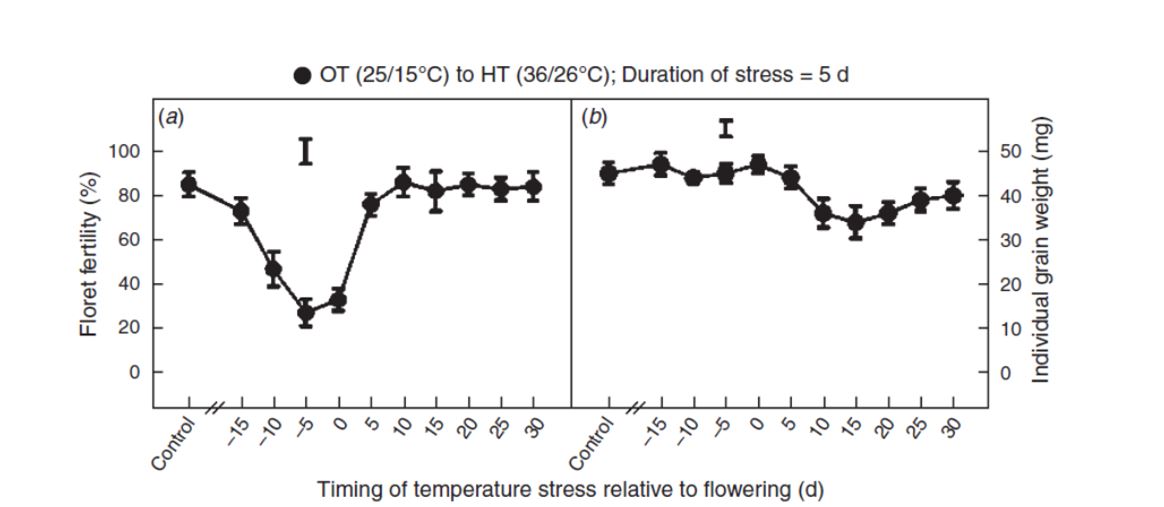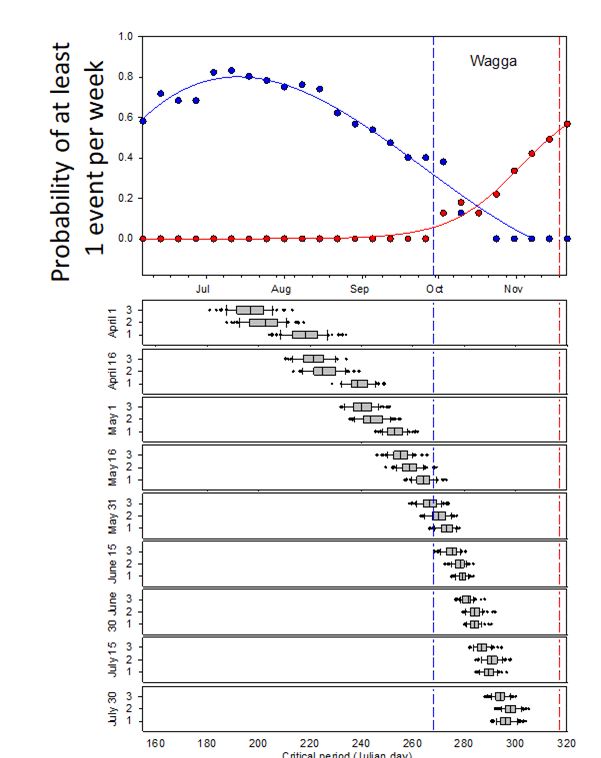Understanding the double effect of high temperature on crop yield
Understanding the double effect of high temperature on crop yield
Author: Victor Sadras, Mariano Cossani and Lachlan Lake (South Australian Research and Development Institute (SARDI)). | Date: 18 Feb 2020
Take home messages
- Crop yield is a primary function of grain number per unit area; grain weight is secondary.
- Grain number is defined in a crop-specific critical period. The most critical stage is shortly before flowering in cereals, and shortly after flowering in pulses and canola.
- There are two distinct effects of elevated temperature. First, elevated non-stressful temperature that shortens the critical period, hence reducing grain number and yield; for example, 1oC increase in mean temperature in critical period of wheat in South Australia (SA) reduces yield by 0.2 to 0.6t/ha. Second, elevated stressful temperature that causes sterility; stressful temperatures are low 30oCs for cereals and low to mid-30oCs for pulses.
- Focus on growth and stress avoidance during critical period for grain set.
Grain yield depends on grain number; grain weight is secondary
Relatively small variation in yield (5-10%) can be related to either grains per m2 or grain weight. Large variation in yield (50% or more) is necessarily associated with grain number (Figure 1). This relates to the universal principle that crops accommodate environmental variation by adjusting grain number; it applies to all cereals, pulses, and oil-seed crops.
Figure 1. For a collection of 845 wheat crops world-wide, grain number accounted for 80% of the variation of yield in a range of failed crops to 15t/ha. Source: Slafer et al. (2014).
Grain number is defined in a crop-specific critical window
Grain number in cereals is defined in a critical developmental period from stem elongation to 10 days after flowering, with the most sensitive stage about two weeks before flowering (Figure 2). The most critical period is displaced to about two weeks after flowering in pulses and canola (Figure 2). Management should therefore aim at maximising growth rate and reducing the likelihood of stress during this critical stage. A longer duration of the critical period also favours yield, as discussed in next section.
Figure 2. The critical period for yield determination in crops. Cereals are shown in black, pulses and canola in grey.
There are two distinct effects of elevated temperature on crop development, growth and yield
There are two distinct aspects of elevated temperature on crop development, growth and yield. One is high temperature that is not necessarily stressful but reduces yield by shortening the critical period. For example, in the experiments of Paul Telfer and colleagues in SA, yield declined at 0.39t/ha per each oC increase in maximum temperature in the critical period in a range from 20 to 26oC (Figure 3).
Figure 3. Wheat yield declines with increasing temperature in critical period. This study defines the critical period from 300-degree days before flowering to 100-degree days after flowering. Each point is the average of 24 varieties in 13 environments in SA. Source: Telfer et al. (2018).
The actual decline in yield per each oC increase in temperature depends on other factors. This is illustrated in Figure 4 for a large set of crops in SA combining four sites-seasons, nitrogen rates from nil to 200kg N/ha, sowing date from early May to early July and cultivars Axe, Cobra, Mace, Scout, and Spitfire. Figure 4a shows two things:
- a large scatter, associated with all these sources of variation, and a trend for an ‘upper limit’, similar to French and Schultz (1984) for the relationship between yield and water use. In 2017, the seasonal rainfall was 198mm to 260mm with no significant frost events and the decline in yield was 0.60t/ha per °C mean temperature in the critical period (Figure 4b). In 2018, rainfall was lower (118mm to 162mm) and some crops were severely frosted; under these constraints, yield response to temperature was attenuated to 0.20t/ha per °C mean temperature in the critical period (Figure 4b). For comparison, with Figure 3 reporting 0.39t/ha per °C maximum temperature, Figure 4c shows a range from 0.27 to 0.42t/ha per °C maximum temperature in lower and higher-yielding seasons, respectively.
Figure 4. The effect of temperature during the critical period on yield depends on other growing conditions. (a) Wheat yield versus mean temperature in the critical period for wheat crops in SA in higher (2017) and lower-yielding (2018) seasons. The scatter is related to site-season, variety, nitrogen rate and sowing date. Upper limit of yield as a function of (b) mean and (c) maximum temperature in the critical period. In this study, critical period was defined from 20 days before to 10 days after flowering. Source: unpublished data from GRDC Project DAS00166_BA. - The second effect of elevated temperature is heat stress that compromises grain set or grain filling. For example, temperature over 31 oC can cause sterility and severe yield losses in wheat, as illustrated in Figure 5a. Note the similarity between the curves in Figure 2 and Figure 6a, reinforcing the notion of critical period. Also note the large effect of heat stress on floret fertility compared to grain weight (Figure 6b).
Figure 5. Effects of five days of heat stress on (a) floret fertility and (b) individual grain weight in wheat. Heat stress was 36 oC day, 26 oC night in comparison to unstressed controls at 25 oC day, 15 oC night. Source: Prasad and Djanaguiraman (2014).
Combining sowing date and variety seeks to set the critical period in a safe window accounting for the trade-off between frost and heat, as illustrated for faba bean in Wagga Wagga (Figure 6).
Figure 6. Top: probability of at least one frost (initial upper line) or heat (initial lower line) event per week in Wagga Wagga. Frost is below 0 oC, and heat over 34 oC. Dashed lines limit a safe window with 10% probability of frost and 30% probability of heat. Bottom: modelled timing of critical period for faba bean combinations of sowing date, and maturity type (1: earl, 2: mid, 3: late).
Expect larger returns from focus on growth during critical period for grain set
Crop establishment is of course important – we don’t want patchy stands. Likewise, grain filling is important – we don’t want small grain and screenings. However, grain yield is mostly correlated with grain number, and grain number is most sensitive to stresses in the crop-specific periods – before flowering in cereals, and after flowering in pulses and canola. Consequently, management for high yield should seek: a) long duration of the critical window (mild temperature), (b) high crop growth rate (for example, good nutrient supply), and (c) low risk of frost and heat during the critical window.
Given that grain number is the dominant driver of crop yield, it is worth asking how much we focus on crop establishment, critical period and grain filling.
Acknowledgements
The research undertaken as part of this project is made possible by the significant contributions of growers through both trial cooperation and the support of the GRDC, the authors would like to thank them for their continued support.
References
French RJ, Schultz JE (1984) Water use efficiency of wheat in a Mediterranean type environment. I. The relation between yield, water use and climate. Australian Journal of Agricultural Research 35:743-764
Prasad PVV, Djanaguiraman M (2014) Response of floret fertility and individual grain weight of wheat to high temperature stress: sensitive stages and thresholds for temperature and duration. Functional Plant Biology 41:1261-1269
Slafer G, Savin R, Sadras VO (2014) Coarse and fine regulation of wheat yield components in response to genotype and environment. Field Crops Research 157:71–83
Telfer P, Edwards J, Bennett D, Ganesalingam D, Able J, Kuchel H (2018) A field and controlled environment evaluation of wheat (Triticum aestivum) adaptation to heat stress. Field Crops Research 229:55-65
Contact details
Victor Sadras
South Australian Research and Development Institute
victor.sadras@sa.gov.au
GRDC Project Code: DAS00166_BA,


